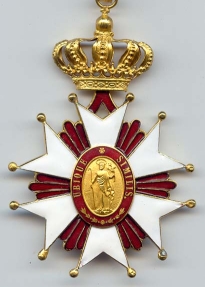Order of St. Joseph (Tuscany)
The Order of St. Joseph ( Italian Ordine del merito sotto il titolo di S. Giuseppe di Toscana ) was a Tuscan knightly order and was established as an Order of Merit as early as 1514 .
Grand Duke Ferdinand III. reintroduced this order on March 19, 1807, when he was still Grand Duke of Würzburg . He renewed it in 1817 after the Duchy of Tuscany had returned to the founder in 1814 after 13 years . The order of knights was the second of its kind in the duchy.
It could be awarded to clergy, civil and military persons and also to foreigners. The commitment to Catholicism was one of the conditions of the award.
The Italian government abolished the order on March 18, 1860. Medal bearers were allowed to put it on.
Order classes
After the change of statutes of March 18, 1817 the order had three classes; the number of members was limited:
-
 1st class: Grand Cross to 20 members
1st class: Grand Cross to 20 members -
 Second class: Commander to 30 members with the prospect of hereditary nobility
Second class: Commander to 30 members with the prospect of hereditary nobility -
 III. Class: Knight to 60 members.
III. Class: Knight to 60 members.
Grand Master was the reigning Grand Duke.
Order decoration
All cross points of the six-armed, white enameled cross with a golden border are set with a total of twelve small golden balls. In each of the cross angles there are three red enamelled rays with gold edging.
The oval medallion shows on the front in gold an image of St. Joseph with the inscription UBIQUE SIMILISas the motto of the order . On the back there are the letters S. J. F.(Sto Josepho Ferdinandus) and the year 1807. The cross arm pointing upwards is connected to a short, red enameled piece of ribbon on a golden openwork crown with a carrying ring.
Ribbon and way of wearing
The ribbon is red with a wide border on both sides. The Grand Cruisers wear this medal as a sash over the right shoulder to the left hip. The commander's cross is worn as a neck medal , by the knights in the buttonhole or as a breast star on the left side.
A silver breast star of the same shape and type, but without a crown, belongs to the Grand Cross . On special occasions, the Grand Cross is worn as a collar around the neck. The chain consists of golden rosettes and gemstones set in the same way . The stones are set in a red enamelled part like a flame on the right and left.
Known porters
- Napoleon Bonaparte
- Charles-Maurice de Talleyrand-Périgord
- Jean-Auguste-Dominique Ingres
- Francis II
- Friedrich August I.
- Alfons of Bavaria , Grand Cross
- Ferdinand von Malaisé , Bavarian general and educator of King Ludwig III.
The order today
The order was revitalized as an Order of Merit in Tuscany in 1972, is still active and honors personalities who have made a name for themselves through their special efforts in art and culture. Grand Master is the Grand Duke of the Tuscan line of the House of Habsburg, Sigismund von Habsburg-Lothringen.
literature
- Kaspar Friedrich Gottschalck: Almanac of the orders of knights. Goeschen, Leipzig 1818.
- Dieter Schäfer: Ferdinand of Austria, Grand Duke of Würzburg, Elector of Salzburg, Grand Duke the Elder. Tuscany. Cologne, Graz, Vienna, Verlag Styria, 1988, pp. 172–175;
- Anton Chroust : History of the Grand Duchy of Würzburg (1806 to 1814). The foreign policy of the Grand Duchy. Wuerzburg 1932
- Gregor Gatscher-Riedl, Mario Strigl, The Red Knights. Between Medici, Habsburgs and Ottomans. The orders and decorations of the Grand Duchy of Tuscany. Vienna, Neue Welt Verlag, 2014. ISBN 978-3-9503061-5-6 .
Individual evidence
- ^ The imperial and royal house of Habsburg-Lorraine ( Memento of November 4, 2011 in the Internet Archive )


